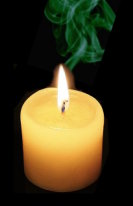 Candles were once used as a primary source of light, but now they litter people's homes as decorations, relaxants, and scenting agents. Most people never consider the possible health implications of candles, and may find themselves shocked by the new "lead-free" labels on certain brands.
Candles were once used as a primary source of light, but now they litter people's homes as decorations, relaxants, and scenting agents. Most people never consider the possible health implications of candles, and may find themselves shocked by the new "lead-free" labels on certain brands.
Prior to 2003, candle wicks were tainted with lead compounds, and often antimony. They were shown to release large amounts of lead vapors into the air. The U.S. Consumer Product Safety Commission subsequently banned the importation and sale of wicks that contain lead compounds. American companies that use wicks laced with metallic compounds switched to using zinc and tin. However, many imported candles still contain lead compounds, in spite of the 8-year-old ban. Customs officials are not exactly busy testing candle wicks, so the poisoning is allowed to continue. Once again, our reliance on unreputable countries like China has left Americans with reduced quality products and poisonings.
However, this is not the only chemical danger from candles. Throughout history, a variety of substances has been used to make candles. During the Roman Age, candles were made from a specific type of fish oil, and much later, tallow (fat from meats) was used. Tallow often emitted a repugnant smell, so beeswax soon became a more popular candle-making material. Eventually, it would be replaced by paraffin. Paraffin was first made from coal tar in 1835, and became commercially available in 1850. Stearic acid had to be combined with paraffin to make it usable, because paraffin alone has a low melting point.
A study at the University of South Carolina has now shown that plain paraffin candles give off carcinogenic vapors containing benzene, toluene, mercury, and acetone. Another study showed that formaldehyde is also released. The researchers who conducted the latter study recommended avoiding paraffin candles, and instead using soy or beeswax alternatives. We have always recommended against soy products, in every form. We all know the dangers of ingested soy, and with each study seems to come even more damning evidence against it. Beeswax has the highest melting point of all three options, so beeswax candles should last the longest, in addition to being the safest of all candle materials.
Modern candles frequently contain fragrances, adding to their chemical output. There are some candles that even contain the same dangerous chemicals as recent air fresheners, which are typically designed to impair the nose's ability to smell. Remember that the new generation of air fresheners (eg. "Febreze") cause asthma, heart trouble, and permanent lung damage. Most scented candles emit phthalate compounds, just as the modern air fresheners do. These are hormone disruptor's that have been tied to birth defects and sperm reduction.
Epilogue
We recommend only purchasing beeswax candles that are labeled to be lead free, and which originate from a nation that does not target children to poison as a matter of official governmental policy. We also ask that you alert your friends of the dangers of candles that are made with industrial strength poisons. Whenever something is used to chemically alter scents, or our very ability to smell, we should always stop to contemplate the process through which that alteration is made. Taking responsibility for our health in this manner is the only way to maintain long term health.
Related Articles
How Air Fresheners Are Killing You
Why Air Fresheners Are A Terrible Health Compromising Idea
Episode 6 of The Health Wyze Report (Audio Edition)
Soy is Unfit for Human Consumption
How Some Gyms Are Very Dangerous To Health and How They Might Even Eventually Kill You
Lead In Fruit Juices, Fruit Snacks, and Children's Drinks
Why Air Fresheners Are A Terrible Health Compromising Idea
The Dangers of Non-Stick Cookware
Lead In Fruit Juices, Fruit Snacks, and Children's Drinks
Recognizing if Your Beef is Toxic: The Next Generation of Food Poisons
Why a Stick of Chewing Gum is More Harmful To Your Health Than Anything You Eat
